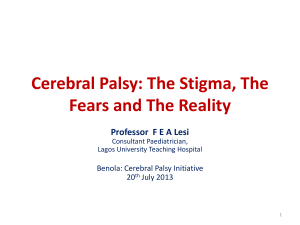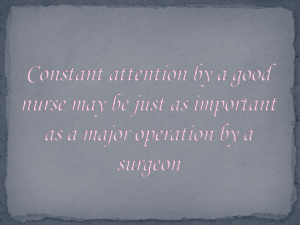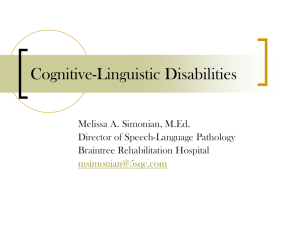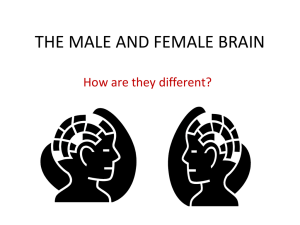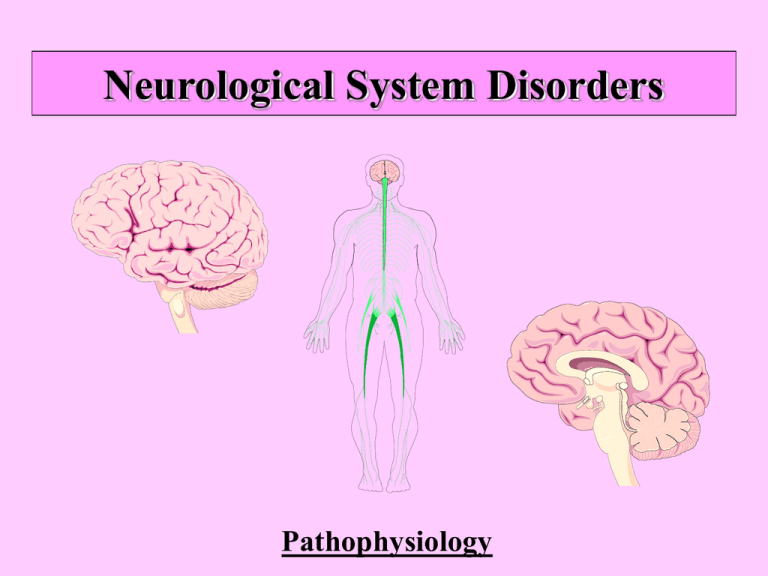
Neurological System Disorders
Pathophysiology
A & P Review of Nervous System
Divisions
– CNS = Brain & Spinal Cord
– Brain Divisions (in ascending order)
– PNS = Motor Nerves (efferent) &
» Brain Stem
Sensory Nerves (afferent)
* Medulla Oblongata
» Cranial Nerves = 12 pair
* Pons
» Spinal Nerves = 31 pair
* Midbrain
» Cerebellum
» Diencephalon
– ANS = Parasympathetic (Cholinergic)
* Hypothalamus
* Thalamus
» Cerebrum
Sympathetic (Adrenergic)
» These primarily control
involuntary muscles &
glands
•
–
Brain Stem has 3 parts (in ascending order)
Generally brain stem is white matter with some scattered gray matter
•
•
Medulla Oblongata
–
–
Pons
–
–
•
Regulates vital functions (cardiac, respiratory, & vasomotor)
Crossing over of corticospinal tracts (decussation)
Connects cerebellum to brain stem & relays sensory input to
cerebellum & thalamus
Has nucleus to control respiration (medulla also has these)
Midbrain
–
–
–
Processes visual & auditory sensory input
Coordinating muscle motor movements
Maintains consciousness via reticular activating system(RAS)
•
RAS
– Determines degree of
arousal & awareness of
cerebral cortex
– Gatekeeper for incoming
sensory impulses
• Cerebellum
– has gray matter (outer layer) & white matter (inner core)
• Gray matter = nerve cell bodies ; white matter = myelinated axons
– controls : coordination & balance (proprioception)
– It coordinates between what the cerebral cortex wants how the PNS reacts
• Diencephalon (literally means between the brain)
– Has 2 major structures
• Thalamus
– “gatekeeper” for sensory input to cerebrum
» e.g. to allow sleep it shuts down input to cortex
– Relay station of motor impulses between cerebrum & subcortical
motor centers
• Hypothalamus
– coordinates impulses between nervous system and endocrine system
– Controls the ANS (coordinates voluntary & autonomic functions)
– Controls emotions & behavior (e.g. hunger, pain, pleasure, sex, etc)
» Connects limbic system with ANS (see n ext slide)
– Controls homeostasis (e.g. regulates temperature)
– It’s an endocrine gland (controls ant pit & is post pit)
• Limbic System
– Connected nuclei in cerebral hemispheres that encircle superior part of brain
stem
– Functions
• Emotions& feelings
• Drives ones behavior which is a result of emotions & feelings
• Links cognitive intelligent thought from cerebral frontal lobes with
emotions(derived from memory) Memory & memory retrieval
– Reactions this process causes is done via hypothalamus
– Example:
•
•
•
•
Think about exam
Memory of poor result in past
Get nervous (stress)
BP increases
• Cerebrum
• largest part of brain
– 2 halves called “hemispheres”
» Each hemisphere divided into 4 lobes
*Frontal, Parietal, Temporal, & Occipital
» Lobes into convolutions (gyri) & fissures (sulci)
– Connected at lower mid-portion called corpus callosum
• gray matter = outer layer; white matter = inner area
• basal ganglia = areas of gray matter deep within white matter
– They are part of extrapyramidal system which coordinates skeletal muscle
activity
» Controls proprioception (posture & involuntary skeletal muscle
movements)
» Connected to nuclei in mid brain & cerebellum
• Functional areas (generally) ------- see next slide
– Lobes
» Frontal = motor, higher thought
-Parietal= sensory
» Temporal = hearing
- Occipital = vision
– Language center
» Expressive area = Broca’s area = base of premotor area frontal lobe
» Sensory area = Wernicke’s area = posterior temporal lobe
Blood supply to brain
•
Arterial supply via
– Carotid –to--internal carotid– into-- circle of Willis
– Subclavian --to– vertebral – into– circle of Willis
•
Venous return via dural sinuses into internal jugular
• Circle of Willis
– vasculature located at base of brain
• Vertebral Arteries -to- Basilar -toPosterior Cerebral -to- Post. Communicating
• Internal Carotid -into- Middle Cerebral &
Anterior Cerebral
• Ant. Cerebral -to- Ant. Communicating
•
•
•
•
Anterior cerebral supplies frontal lobes
Middle cerebral supplies temporal &
parietal lobes
Basilar artery supplies brainstem &
cerebellum
– Branch off vertebral to cerebellum
Posterior cerebral supplies occipital lobes
Coverings & Fluid Compartments in CNS
• Meninges = layers of tissue that cover the CNS
– 3 layers
• Dura mater = tough outer layer
– Brain has 2 dural layers which are fused together except in certain areas
where they form dural sinuses
» These collect blood from brain & direct it into internal jugular veins
• Arachnoid = filmy middle layer
– Arachnoid villi = CSF back into blood (into superior sagittal sinus
• Pia mater = innermost layer
• Cerebrospinal fluid
– Formed by choroid plexus located in roof of each ventricle
– Made up of capillaries within pia & ependymal cells
– Continuously circulating fluid
– Avg amt to fill area = 150 cc; replaced every 8 hours
– Outside the CNS – fluid in subarachnoid space of brain & cord
– Inside the CNS:
• 2 lateral ventricles connected via interventricular foramen
• Third ventricle
• Cerebral aqueduct – connects 3rd with 4th ventricle
• Fourth ventricle between cerebellum & brain stem
– From 4th ventricle fluid enters either subarachnoid space of
brain or goes down central canal of cord
» Lateral & medial apertures in wall of fourth ventricle allow fluid to
enter subarachnoid space
Autonomic Nervous System
• Sympathetic
–
–
–
–
Adrenergic system
Use: stress or emergency
3 F’s– Fright flight, or fight
agonists
• sympathomimetics
• adrenergics
– antagonists
• sympatholytics
• adrenergic blockers
• Parasympathetic
– Cholinergic system
– Use: normal everyday things
– 2 R’s-- rest & rumination
– agonists
• parasympathomimetics
• cholinergics
– antagonists
• parasympatholytics
• anticholinergics
sympathetic
1. origin of
first neuron
2. ganglia location
parasympathetic
thoracic & upper lumbar
part of spinal cord
mid-brain & medulla in
brain stem ; sacral cord
near the spinal cord
near the target organ
Ganglia location produces different responses:
Sympathetic ganglia stimulation = get whole system
Parasympathetic ganglia = just effector organ stimulated
3. neurotransmitters:
preganglionic
postganglionic
(see next slide)
ACH
* Nor - Epinephrine
* Dopamine is : 1. a neurotransmitter
2. a precursor of nor- epinephrine
3. works as an antagonist to acetylcholine
ACH
ACH
ANS Receptors
• Sympathetic
– Alpha
• Alpha-1
– mainly on smooth
muscle of vessels - get
constriction
• Alpha-2
– Inhibitory; on
preganglionic axon knob
• Parasympathetic
– muscarinic
• on cardiac & smooth
muscle
– nicotinic I (Ng)
– Beta
• Beta -1
– on heart musclestimulates rate &
strength
– In kidney for renin
secretion
• Beta -2
– on smooth muscle of
organs -get relaxation
– On skeletal muscle
» Get vasodilation
• on all preganglionic
neurons of ANS
– nicotinic II (Nm)
• on skeletal muscle
General effects of diseases of the nervous system
Cranium
• Supratentorial & infratentorial lesions
– Reference = tentorium cerebelli
– Supratentorial lesions in cerebral cortex
– Infratentorial lesions in brain stem & cerebellum
• Hemisphere lesions
– Dominant hemisphere (usually left) --- logical thinking ability
– Other hemisphere (usually right) ----art & behavior
• Level of consciousness
– Def of consciousness = aware of surroundings & oriented to time,
place, & people
– Dependent on RAS & cerebral cortex
– Glasgow coma scale (15 points = normal)
• 3 key things:
– eye opening (4) points
– motor response (6 points)
– Verbal response (5 points)
General effects of diseases of the nervous system (cont)
• Motor dysfunction
• Upper motor neuron = hyperreflexia
• Lower motor neuron = flaccidity, weakness,paralysis
• radiating pain
• Sensory dysfunction
• sensation problems (numbness)
• Peripheral spinal nerves = touch, pain temp, and position
• Cranial nerves = special senses problems
• Language disorders
• Aphasia = inability to comprehend or express language
– Expressive or motor aphasia (Broca’s)
– Receptive or sensory aphasia (Wernicke’s)
– Combination = “global aphasia”
– Alexia = impaired reading ability
– Agraphia = impaired writing ability
General effects of diseases of the nervous system (cont)
• Increased intracranial pressure
– Causes :
– Hemorrhage
– Inflammatory exudate
– Any mass (tumor)
– Results if this increased pressure
– Less blood entering brain
– Compression of brain tissue
– Dispersed pressure from local to general
– Herniation of brain tissue
– BP increased; P & RR decreases
– headache,
– N&V
Increased intracranial pressure
– Papilledema
& possible herniations
Neurological disorders
General overview
• Acute problems
– Tumors
– Vascular disorders
• TIA’s
• CVA’s
• Aneurysms
– Infections
– Head injuries
– Spinal injuries
– Spinal disc problems
• Chronic problems
– Congenital disorders
– Seizure disorders
– Chronic degenerative
disorders
•
•
•
•
•
MS
Parkinson’s
ALS
Myasthenia gravis
Huntington’s disease
– Dementia
– Peripheral nerve disorders
– Psychiatric disorders
Tumors
•
Signs & symptoms of all tumors come from increased intracranial pressure
– From the tumor itself
– From inflammatory swelling
Primary Brain Tumors = arise from the connective tissue cells called “glia”
or arise from the meninges
– Glia Cells: (1) Astrocytes = fasten blood vessels to nerves
(2) Microglia = brain macrophages
(3) Oligodendroglia = form myelin in CNS
– Tx & Px : Meningiomas = fair prognosis
Glial Tumors = poor prognosis
* astrocytoma
* glioblastoma
Secondary Brain Tumors = more common
Vascular Disorders
Cerebral Vascular Accident
•
•
•
condition results from lack of blood supply; also called stroke
Pathophysiology = (1) Thrombus
(2) Embolus
(3) Hemorrhage
– These can occur as a result of:
– Systemic Disease ---------- diabetes, increase lipids, hypertension
– Heart Disease -------------- valvular, arrhythmias
– Trauma
– Risk Factors = lifestyle, family history
Tx = anticoagulants; surgery; rehab
– new :
» treat as emergency
» steroids to reduce edema
* big danger = increase ICP
» fibrinolytic agents
Transient Ischemic Attacks (TIA’s)
• Also called “little strokes”
• Results from temporary localized reduction of blood flow
– Usually get recovery within 24 hours
• etiol :
» emboli ------ plaque , fibrin
» arterial vascular spasm
• May be warning sign of impending major CVA
– New treatment modality = carotid stenting
Cerebral Aneurysms
– Localized dilation in an artery; frequent site = bifurcation in circle of Willis
– Called “berry” aneurysms
– Mortality = high; 35% die with the initial rupture
Infections
Meningitis
• def = inflammation of meninges
• etiol = pathogens
– HI-b ; Neisseria m.; Strept pneumonia (pneumococcal); E.Coli
– N. meningococcus = can get asymptomatic carriers ( in
nasopharynx)
* seen in groups; associated with rash (meningococcemia)
– In neonates E.Coli meningitis most common
– HI-b most common in children --- vaccine available
– Strept = most common in older people --- vaccine available
• Sx = headache, nuchal rigidity, irritability
Encephalitis
• def = inflammation of brain tissue
• etiol = usually viral (frequently transmitted by mosquito)
– May be secondary to vaccinations
• Sx = mental confusion is hallmark of symptoms
Guillain-Barre Syndrome
• Def = Acute, rapidly progressing disease of spinal nerves beginning
in feet/ legs & spreads upward rapidly (1-3 days)
• also called postinfectious polyneuritis
– It’s an inflammatory condition of peripheral nervous system
• Frequently preceded by viral infection or immunization
• Tx = usually complete recovery
– About 30% get residual weakness
Reye’s syndrome
• Etiol: usually viral infection treated with aspirin
– ? Abnormal immune response
• Get brain & liver problems
– Cerebral edema with increase intracranial pressure
» Frequent early sx = change in behavior & personality
– Liver progresses to acute failure
• Mortality = 30% !!!
Head Trauma
• Closed injuries = skull not fractured
• Concussion
• Contusion
• Contrecoup injury
• Open injuries = skull fractured
• Linear fracture
• Depressed fracture
• Basilar fracture
• With either type injury can get hematomas
• Epidural
• Subdural
• Intracerebral
Head Trauma
• Post concussive syndrome
– Any physical trauma to head can give one this syndrome
• Do not confuse with posttraumatic stress disorder
– This secondary to terrifying trauma exposure
– Approx 7% - 10% incidence
– Gives person “painful recollections”
* Irritability
* Insomnia
*Can’t respond to affection
– Post concussive syndrome = 50% incidence
• Sx: headache, somatic & psychologic complaints; cognitive impairments
Closed injury --- direct & contrecoup
Open injury ---- depressed fracture
Hematomas
•
3 types
• Epidural ----- between skull & dura
– Usually temporal area trauma
– Get symptoms within few hours
» Loss od consciousness
• Subdural ----- between dura & arachnoid
– Acute (sx w/in 24 hours)
– Subacute (sx w/in 1-2 weeks)
• Intracerebral
– May take several days to develop after
injury
• Sx = N&V, headache, loss of
consciousness,
coma, death,
dilated pupil
• etiol = trauma
• Tx = surgery (craniotomy)
see next slide
Cerebral Concussion
• temporary disruption of brain’s electrical activity
• Sx = loss of consciousness
may also get amnesia (+/-)
• usually lasts for less than 24 hours
Cerebral Contusion
• get bruising of brain tissue, thus more serious than concussion
• often associated with skull fracture
• Sx = loss of consciousness & lasts more than 24 hours, may go
into coma
• May get residual damage
• High incidence of “post concussive syndrome” --- if blow severe
Depressed Skull Fracture
• Sx = non-progressive, but static until pressure relieved
• may get epilepsy
• may get Posttraumatic Stress Disorder
Basilar Skull Fracture
•
•
•
•
•
Occurs at base of skull
Area where circle of Willis is very close to subarachnoid space
Can get blood into cerebral spinal fluid
Can get leakage of CSF from ears & nose
Etiol: trauma to base of skull
– Posterior fossa if occipital bone involved
– Middle fossa if temporal bone involved
• These hard to diagnose since fracture frequently occult
– Get air in sinuses or intracranially = key to diagnosis
Spinal Cord Injuries
• General trauma to vertebrae ---- get fracture or dislocation
– Common areas of spine = mobility areas , not support areas
– Cervical area C1 to C7 ------ neck mobility
– T12 to L2 ------ movable area at junction of chest & abdomen
– Examples: hyperflexion of head, hyperextension of head, compression fx
• Penetration injuries occur to any area of spine
see next slide
Spinal Cord Injuries
•
•
•
•
usually get paraplegia or quadriplegia === depending on injury level
Injuries above C3 usually result in death
Injury at C2 to C5 may damage phrenic nerve & diaphragm paralyzed
With acute injury may go into Neurogenic Shock (spinal shock)
» Remember:
* As BP decreases, Pulse also decreases
* May get Hypothermia Only in Neurogenic Shock
• Facts about Myelin Regeneration
» In PNS ------------------- Schwann Cells lay down myelin from
their cell membrane ( Neurilemma)
» In CNS ------------------- Oligodendroglia lay down myelin; they
don’t have neurilemma, thus do not
regenerate myelin NOTE: Axons Only
Grow Down Neurilemma of Schwann
Cell
Spinal Shock = major complication of severe injury
•
•
It’s the period immediately following injury
Level of injury determines symptoms
– Get no function below injury (motor or sensory)
•
Major danger = malignant hypertension
– Syndrome of autonomic dysreflexia
– Sympathetic nervous system gets overactive
– Higher center can’t correct this since blockage
Herniated intervertebral disc
•
•
•
•
Cartilaginous discs separate the vertebrae
Herniation of nucleus pulposus through annulus fibrosus
Common areas
– L5/S1
– L4/L5
– C5 through C7
Signs & symptoms depend on location
– Usually unilateral
• Chronic problems
– Congenital disorders
– Seizure disorders
– Chronic degenerative disorders
•
•
•
•
•
MS
Parkinson’s
ALS
Myasthenia gravis
Huntington’s disease
– Dementia
– Peripheral nerve disorders
– Psychiatric disorders
Congenital Neurologic Disorders
Neural tube defects
• When posterior portion of neural tube fails to close between 3 & 4
weeks of embryonic development
• Etiology = unknown
• Incidence = 1/ 1000 births
– 90% occur in pregnancy where there is no definable risk
– if you have had a child with NTD , your risk is increased 10 fold
– second most common congenital defect ( first = Heart defects)
• 5 types
– Spina Bifida (overt or occult)
– Meningocele
– Myelomeningocele --- has neurological symptoms
– Hydrocephalus
– Anencephaly ---- incompatible with life
• Diagnosis via early prenatal test ------ alpha-feto-protein
• Treatment -------- surgery; use of shunts
• Prevention = folic acid
see next slide
Cerebral Palsy (CP)
–
–
–
–
–
–
Def: bilateral, non-progressive paralysis from damage to motor control areas of brain
– occurs in prenatal period, perinatal period, and postnatal period
Most common crippling disease of children
Etiol: anoxia to brain
May or may not have related complications as:
• Mental retardation
• Seizures
• Hearing/vision defects
Most common in premies & males
3 basic types
– Spastic = increase tone, reflexes & rigidity
– Dyskinetic = no fine motor coordination
– Ataxic = gait & stability problems
Seizure Disorders
•
•
Outdated term = epilepsy ------- means recurrent seizures
Def: brain disorder where you get sudden episodes (paroxysmal) of intense
brain activity with resultant seizures
– Classification based on generalized or focal discharge of activity
• Generalized = loss of consciousness
• Focal (partial) = no loss of consciousness
• Etiol:
– Primary seizure disorder - - - etiology unknown
– Secondary seizure disorder - - etiology known
• fever
• hypoglycemia
• trauma ( including birth trauma)
• tumors
• electrolyte imbalances
• Postictal state = time just after the seizure
• Patient usually has confusion for a few moments
• Classification:
– Generalized --- lose consciousness; aura
– Absence (petit mal) === no aura; brief (10 sec)
– Myoclonic --- sudden jerking of one (or more) extremity &
fall suddenly to ground; occur in clusters
– Tonic --- whole body; infants & children
– Tonic- clonic --- whole body; children & adults (2-5 minutes)
– Partial --- no loss of consciousness
– Simple --- slow repetitive jerking of body part
– Complex (temporal lobe/ psychomotor) --- get automatisms
» Exp = lip smacking, chewing, facial grimacing, swallowing
– Status epilepticus
•
Clinically a generalized convulsion is described as a “Tonic-Clonic Seizure”
» In Tonic Phase ----- get body stiffening
» In Clonic Phase ---- get body jerking
Chronic degenerative disorders
• MS ------------------------- multiple sclerosis; demyelination
• Parkinson’s --------------- synaptic disease; no dopamine
• ALS ------------------------- amyotrophic lateral sclerosis ; lateral motor
tracts in spinal cord go bad
• Myasthenia gravis -------- autoimmune lack of acetylcholine receptivity at
synapse; usually facial & unilateral
• Huntington’s disease ----- autosomal dominant genetic defect; in brain &
basal ganglia get neurotransmitter deficiency
of Ach & GABA
Key = chronicity & progression
Multiple Sclerosis
•
•
•
•
•
Def: Inflammatory disease of the CNS where the myelin sheath is destroyed
Etiol: ? Autoimmune
General information:
• Occurs between ages 20 – 40; women > men (1.5>1)
• 2 main types
– Exacerbation/remitting type
» Get step-like progression
– Chronic progressive type
• Onset of first episode may be rapid
– Can occur over a few hours
Symptoms
– Transient weakness of limbs--- from demyelination of tracts in cord
» Monoparesis, hemiparesis, paraparesis
– Sudden loss of vision in one eye
– Transient onset of cerebellar disease
» Unsteady, vertigo, tremor of intention
Prognosis
• Generally, average life span with the disease = 30 years
Parkinson’s disease
•
•
Pathophysiology
– Get degeneration of cells in
substancia nigra(gray matter
in midbrain) . These cells
produce dopamine
– Substancia nigra
interconnected to basal
ganglia deep in cerebral cortex
(thus brain’s control of
movement out of sync
General features
– Average age of onset = 60
– Avg life span with disease = 10
–15 years
– Get
– mild tremors
* pill-rolling
– shuffling gait
– muscle rigidity
– This is really a disease of the synapse (i.e. no dopamine neurotransmitter)
• Physiology:
» acetylcholine & dopamine work in opposition to each other as skeletal
muscle neurotransmitters
* acetylcholine = increases muscle tone & activity
* dopamine = decreases muscle tone and activity
– Clinical Picture
– Avg Age Onset = 60 ; Avg Life Span = 10 years
– Early Symptoms = pill-rolling tremor, muscle rigidity, shuffling gait
– Late Symptoms = behavioral changes, dementia(25%), mask-face
•
Treatment
– Key = increase levels of dopamine; decrease levels of acetylcholine
– Dopamine has problems crossing blood-brain barrier
– Med = L-dopa
– What’s new
» New drugs to increase amount of dopamine that goes to brain
» Electrical implants
» Tissue implants
Amyotrophic Lateral Sclerosis (ALS)
– Also called Lou Gehrig’s Disease
– Usually appears between age 40 – 60
– Pathophysiology
– Motor neuron degeneration without inflammation
– One type is genetic (chromosome 21 defect)
– get progressive destruction of upper & lower motor neurons by means of
destruction of lateral corticospinal tracts with resultant muscle atrophy
– Usually begins in hands & forearms (flaccidity)
– Then affects upper motor neurons by ruining tract (axon) first (spasticity)
• Remember -- Lower motor neurons gives flaccidity
• Upper motor motor neurons give spasticity & hyperreflexia
– get no sensory involvement & no cognitive impairment
– Prognosis = death via respiratory failure in 2- 5 years
Myasthenia gravis
•
•
•
•
•
•
Pathophysiology: antibodies take out Ach receptors &
eventually muscle won’t work
– Occurs gradually
– Get weakness (asthenia) & fatigue
– Primarily face & eyes
– May affect arm & trunk muscles
Etiol: autoimmune
• Associated sometimes with thymoma
Women (avg age 30) > men (avg age 50)
Dx: Tensilon test (short acting anticholinesterase)
Complication: myasthenic crisis
– Muscle weakness spreads to the respiratory
muscles & get respiratory impairment
Treatment plan is to increase effect of Ach by using
anticholinesterases
– Future: ? Immunomodulators
Huntington’s chorea (disease)
• Degenerative disease of cerebral cortex & basal ganglia
– Neurons fail to secrete Ach & GABA (inhibitory)
• Chorea = involuntary, ceaseless, purposeless movements
• Etiol = genetic; autosomal dominant (on chromosome #4)
• Pathophysiology = progressive atrophy of brain neurons
especially in frontal cerebral cortex & basal ganglia
• Key = progressive chorea & dementia
• Onset of impairment begins in early adult life (25yrs – 35
yrs)
Dementia
Alzheimer’s disease
• Accounts for 50% of dementia cases
• Incidence in people over 65 ----- 15%
• Pathophysiology: (see next slide)
– Cortical atrophy
– Neurofibrillary tangles
– Plaques of amyloid
– Defect in neurotransmitter Ach in brain
• Used to be called “presenile dementia”
– Senile dementia = vascular dementia
• Average age of onset ---- between age 65 – 75
• Clinically
– First memory loss & lack concentration & lose
emotional control
– Loss of cognitive function & can’t do daily living
activities
• Survival up to 20 years, but average = 7
Dementia
HIV (AIDS)
– Virus is directly neuro-toxic especially in cerebral cortex
– Seen in later stages of the disease
– In congenital HIV infection, get frequent retardation
Vascular dementia
– Also called senile dementia --- an age related phenomenon
– Patients generally older than 70
– Risk factor = hypertension
Creutzfeldt – Jakob Disease
– Etiol = prion (an altered protein particle)
– Long incubation period
– Get rapid destruction of neurons
– Spongioform encephalopathy
– Related to bovine spongioform encephalopathy
– Mad cow disease
– Transmissible
Peripheral Nerve Disorders
Peripheral Neuritis
• Get degeneration of peripheral nerves (both Motor & Sensory)
• Insidious Onset; Usually affects hands & feet
• Etiol = (1) Toxins------ Alcohol, lead, Arsenic
(2) renal failure --- uremic poisoning
(3) Metabolic Diseases ------ diabetes, alcoholism
(4) Dietary deficiencies ----- vitamin deficiency e.g. Beriberi
(niacin deficiency)
Trigeminal Neuralgia (Tic Douloureux)
• pain in area of 5th cranial nerve
– 3 branches: ophthalmic, maxillary, mandibular
• Sx = Sudden Onset of Pain; Unilateral
– can be set off by chewing, swallowing, or touching
Bell’s Palsy
• Sudden onset of motor paralysis of 7th cranial nerve ( FACIAL)
• Sx = usually unilateral with drooping & drooling
• Etiol = ?? , seen with viral illnesses, maybe seen in Lyme Disease
Psychiatric disorders
•
3 basic classes
• Personality disorders
» Tx: awareness & self improvement
• Neurotic behavior
» Tx: out-patient psychiatric care with good prognosis
• Psychotic behavior
» Tx: in-patient psychiatric care with poor prognosis
Panic attack & panic disorder (anxiety disorder)
– Panic attack sudden brief episode of discomfort & anxiety
• Dx as personality disorder
– Panic disorder = when panic attacks frequent & prolonged
• Dx as neurotic disorder
– Pathophysiology:
• abnormal problems with neurotransmitters
– Norepinephrine,serotonin, GABA
• irritability of the limbic system
– Memories evoke panic
Schizophrenia
– Psychotic disorder
– Pathophysiology = dopamine excess; disorganized thought
– Sx:
• Positive group = delusions & bizarre behavior
• Negative group = flat emotions & decreased speech
– Clinically get pure groups or combinations
Depression
– Neurotic or psychotic
– Types
• Major unipolar depression
• Bipolar disorder
• Reactive (situational) depression
– Pathophysiology = decreased activity in brain of excitatory neurotransmitters
• These are norepinephrine & serotonin





